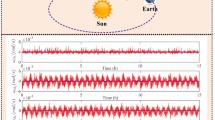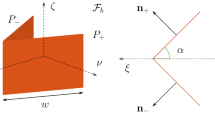Abstract
The evolution of the attitude angle and the mechanical energy exchange between the bus system and the solar sail via the connecting wires are the main manifestations of the coupling dynamic effects on the orbit evolution, the attitude adjusting and the flexible vibration of the tethered satellite system. To investigate attitude evolution of the tethered system and the mechanical energy transfer/loss characteristics between the bus system and the solar sail via the connecting wires, a structure-preserving method is developed in this paper. Simplifying the tethered satellite system as a composite structure consisting of a particle and a flexible thin panel connected by four special springs, the dynamic model is deduced via the Hamiltonian variational principle firstly. Then, a structure-preserving approach that connects the symplectic Runge–Kutta method and the multi-symplectic method is developed. The excellent structure-preserving property of the numerical scheme constructed is presented to illustrate the credibility of the numerical results obtained by the constructed structure-preserving approach. From the numerical results on the mechanical energy transfer/loss in the composite structure, it can be found that the mechanical energy transfer tendency in the tethered system is dependent of the initial attitude angle of the system while the total mechanical energy loss of the system is almost independent of the initial attitude angle. In addition, the special stiffness range of the spring is found in the attitude angle evolution of the system, which provides a structural parameter design window for the connecting wires, that is, the duration needed to arrive the stable attitude is short when the stiffness of the wire is designed in this special range.
Graphic Abstract
The evolution of the attitude angle and the mechanical energy exchange between the bus system and the solar sail via the connecting wires are the main manifestations of the coupling dynamic effects on the orbit evolution, the attitude adjusting and the flexible vibration of the tethered satellite system. To investigate attitude evolution of the tethered system and the mechanical energy transfer/loss characteristics between the bus system and the solar sail via the connecting wires, a structure-preserving method is developed in this paper. Simplifying the tethered satellite system as a composite structure consisting of a particle and a flexible thin panel connected by four special springs, the dynamic model is deduced via the Hamiltonian variational principle firstly. Then, a structure-preserving approach that connects the symplectic Runge-Kutta method and the multi-symplectic method is developed. The excellent structure-preserving property of the numerical scheme constructed is presented to illustrate the credibility of the numerical results obtained by the constructed structure-preserving approach. From the numerical results on the mechanical energy transfer/loss in the composite structure, it can be found that the mechanical energy transfer tendency in the tethered system is dependent of the initial attitude angle of the system while the total mechanical energy loss of the system is almost independent of the initial attitude angle. In addition, the special stiffness range of the spring is found in the attitude angle evolution of the system, which provides a structural parameter design window for the connecting wires, that is, the duration needed to arrive the stable attitude is short when the stiffness of the wire is designed in this special range.





Similar content being viewed by others
References
Glaser, P.E.: Power from the sun: its future. Science 162(3856), 857–861 (1968)
Yu, B.S., Wen, H., Jin, D.P.: Review of deployment technology for tethered satellite systems. Acta Mech. Sin. 34(4), 754–768 (2018). https://doi.org/10.1007/s10409-018-0752-5
Kalaghan, P., Arnold, D., Colombo, G., et al.: Study of the dynamics of a tethered satellite system (Skyhook). Final Report Contract NAS8 32199 (1978)
Carroll, J.A.: Tether applications in space transportation. Acta Astronaut. 13(4), 165–174 (1986). https://doi.org/10.1016/0094-5765(86)90061-5
Guerriero, L., Vallerani, E.: Potential tether applications to space station operations. Acta Astronaut. 14, 23–32 (1986). https://doi.org/10.1016/0094-5765(86)90107-4
Dematteis, G., Desocio, L.M.: Dynamics of a tethered satellite subjected to aerodynamic forces. J. Guid. Control Dyn. 14(6), 1129–1135 (1991). https://doi.org/10.2514/3.20767
Dobrowolny, M., Stone, N.: A technical overview of TSS-1: the first tethered-satellite system mission. Il Nuovo Cimento C 17(1), 1–12 (1994)
Glaese, J.R.: Tethered satellite system (TSS) dynamics assessments and analysis, TSS-1R Post Flight Data Evaluation. NASA NASA-CR-201138 (1996)
Lavoie, A.R.: Tethered satellite system (TSS-1R)-post flight (STS-75) engineering performance report. NASA JA-2422 (1996)
Cartmell, M.P., McKenzie, D.J.: A review of space tether research. Prog. Aerosp. Sci. 44(1), 1–21 (2008). https://doi.org/10.1016/j.paerosci.2007.08.002
Leamy, M.J., Noor, A.K., Wasfy, T.M.: Dynamic simulation of a tethered satellite system using finite elements and fuzzy sets. Comput. Methods Appl. Mech. Eng. 190(37–38), 4847–4870 (2001). https://doi.org/10.1016/s0045-7825(00)00352-2
Mankala, K.K., Agrawal, S.K.: Dynamic modeling and simulation of satellite tethered systems. J. Vib. Acoust.-Trans. ASME 127(2), 144–156 (2005). https://doi.org/10.1115/1.1891811
Zhao, J., Cai, Z.Q.: Nonlinear dynamics and simulation of multi-tethered satellite formations in Halo orbits. Acta Astronaut. 63(5–6), 673–681 (2008). https://doi.org/10.1016/j.actaastro.2008.04.007
Jung, W., Mazzoleni, A.P., Chung, J.: Nonlinear dynamic analysis of a three-body tethered satellite system with deployment/retrieval. Nonlinear Dyn. 82(3), 1127–1144 (2015). https://doi.org/10.1007/s11071-015-2221-z
Yu, B.S., Jin, D.P., Wen, H.: Nonlinear dynamics of flexible tethered satellite system subject to space environment. Appl. Math. Mech.-English Edition 37(4), 485–500 (2016). https://doi.org/10.1007/s10483-016-2049-9
Shan, M.H., Guo, J., Gill, E.: Deployment dynamics of tethered-net for space debris removal. Acta Astronaut. 132, 293–302 (2017). https://doi.org/10.1016/j.actaastro.2017.01.001
Kumar, K.D.: Review of dynamics and control of nonelectrodynamic tethered satellite systems. J. Spacecr. Rockets 43(4), 705–720 (2006). https://doi.org/10.2514/1.5479
Wen, H., Jin, D.P., Hu, H.Y.: Advances in dynamics and control of tethered satellite systems. Acta Mech. Sin. 24(3), 229–241 (2008). https://doi.org/10.1007/s10409-008-0159-9
Misra, A.K.: Dynamics and control of tethered satellite systems. Acta Astronaut. 63(11–12), 1169–1177 (2008). https://doi.org/10.1016/j.actaastro.2008.06.020
Sun, L., Zhao, G., Huang, H.: Stability and control of tethered satellite with chemical propulsion in orbital plane. Nonlinear Dyn. 74(4), 1113–1131 (2013). https://doi.org/10.1007/s11071-013-1028-z
Ma, Z., Sun, G.: Adaptive sliding mode control of tethered satellite deployment with input limitation. Acta Astronaut. 127, 67–75 (2016). https://doi.org/10.1016/j.actaastro.2016.05.022
Hu, W., Zhang, C., Deng, Z.: Vibration and elastic wave propagation in spatial flexible damping panel attached to four special springs. Commun. Nonlinear Sci. Numer. Simul. (2020). https://doi.org/10.1016/j.cnsns.2020.105199
Hu, W., Deng, Z., Han, S., et al.: Generalized multi-symplectic integrators for a class of Hamiltonian nonlinear wave PDEs. J. Comput. Phys. 235, 394–406 (2013). https://doi.org/10.1016/j.jcp.2012.10.032
Hu, W., Wang, Z., Zhao, Y., et al.: Symmetry breaking of infinite-dimensional dynamic system. Appl. Math. Lett. 103, 10 (2020). https://doi.org/10.1016/j.aml.2019.106207
Hu, W., Deng, Z., Yin, T.: Almost structure-preserving analysis for weakly linear damping nonlinear Schrödinger equation with periodic perturbation. Commun. Nonlinear Sci. Numer. Simul. 42, 298–312 (2017). https://doi.org/10.1016/j.cnsns.2016.05.024
Bridges, T.J.: Multi-symplectic structures and wave propagation. Math. Proc. Camb. Philos. Soc. 121(1), 147–190 (1997). https://doi.org/10.1017/s0305004196001429
Feng, K.: On difference schemes and symplectic geometry. In: Proceeding of the 1984 Beijing Symposium on Differential Geometry and Differential Equations, Beijing 1984, pp. 42–58. Science Press
Hu, W., Ye, J., Deng, Z.: Internal resonance of a flexible beam in a spatial tethered system. J. Sound Vib. (2020). https://doi.org/10.1016/j.jsv.2020.115286
Hu, W., Yu, L., Deng, Z.: Minimum control energy of spatial beam with assumed attitude adjustment target. Acta Mech. Solida Sin. 33(1), 51–60 (2020). https://doi.org/10.1007/s10338-019-00132-4
Hu, W., Huai Y., Xu M., et al.: Mechanoelectrical flexible hub-beam model of ionic-type solvent-free nanofluids. Mech. Syst. Signal Process. 159, (2021). https://doi.org/10.1016/j.ymssp.2021.107833
Sasaki, S., Tanaka, K., Higuchi, K., et al.: A new concept of solar power satellite: tethered-SPS. Acta Astronaut. 60(3), 153–165 (2007). https://doi.org/10.1016/j.actaastro.2006.07.010
Hu, W., Song, M., Deng, Z.: Energy dissipation/transfer and stable attitude of spatial on-orbit tethered system. J. Sound Vib. 412, 58–73 (2018). https://doi.org/10.1016/j.jsv.2017.09.032
Kirchhoff, G.R.: Über das Gleichgewicht und die Bewegung einer elastischen Scheibe. Journal für die reine und angewandte Mathematik 40, 51–88 (1850)
Xu, X.J., Deng, Z.C., Meng, J.M., et al.: Bending and vibration analysis of generalized gradient elastic plates. Acta Mech. 225(12), 3463–3482 (2014). https://doi.org/10.1007/s00707-014-1142-0
Liu, C.S., Li, B.T.: An R(x)-orthonormal theory for the vibration performance of a non-smooth symmetric composite beam with complex interface. Acta. Mech. Sin. 35(1), 228–241 (2019). https://doi.org/10.1007/s10409-018-0799-3
Hu, W., Xu, M., Song, J., et al.: Coupling dynamic behaviors of flexible stretching hub-beam system. Mech. Syst. Signal Process. 151, (2021). https://doi.org/10.1016/j.ymssp.2020.107389
Sanz-Serna, J.M.: Runge–Kutta schemes for Hamiltonian systems. BIT Numer. Math. 28(4), 877–883 (1988). https://doi.org/10.1007/bf01954907
Antonana, M., Makazaga, J., Murua, A.: New integration methods for perturbed ODEs based on symplectic implicit Runge–Kutta schemes with application to solar system simulations. J. Sci. Comput. 76(1), 630–650 (2018). https://doi.org/10.1007/s10915-017-0634-1
Hong, J., Huang, C., Wang, X.: Symplectic Runge-Kutta methods for Hamiltonian systems driven by Gaussian rough paths. Appl. Numer. Math. 129, 120–136 (2018). https://doi.org/10.1016/j.apnum.2018.03.006
Liu, X., Frank, J.: Symplectic Runge-Kutta discretization of a regularized forward-backward sweep iteration for optimal control problems. J. Comput. Appl. Math. 383, 10 (2021). https://doi.org/10.1016/j.cam.2020.113133
Pan, Y., He, Y., Mikkola, A.: Accurate real-time truck simulation via semirecursive formulation and Adams-Bashforth-Moulton algorithm. Acta Mech. Sin. 35(3), 641–652 (2019). https://doi.org/10.1007/s10409-018-0829-1
Torkan, E., Pirmoradian, M., Hashemian, M.: Instability inspection of parametric vibrating rectangular Mindlin plates lying on Winkler foundations under periodic loading of moving masses. Acta Mech. Sin. 35(1), 242–263 (2019). https://doi.org/10.1007/s10409-018-0805-9
Cohen, D., Owren, B., Raynaud, X.: Multi-symplectic integration of the Camassa-Holm equation. J. Comput. Phys. 227(11), 5492–5512 (2008). https://doi.org/10.1016/j.jcp.2008.01.051
Gong, Y., Cai, J., Wang, Y.: Some new structure-preserving algorithms for general multi-symplectic formulations of Hamiltonian PDEs. J. Comput. Phys. 279, 80–102 (2014). https://doi.org/10.1016/j.jcp.2014.09.001
Cai, J., Wang, Y., Jiang, C.: Local structure-preserving algorithms for general multi-symplectic Hamiltonian PDEs. Comput. Phys. Commun. 235, 210–220 (2019). https://doi.org/10.1016/j.cpc.2018.08.015
Chen, C., Hong, J., Sim, C., et al.: Energy and quadratic invariants preserving (EQUIP) multi-symplectic methods for Hamiltonian wave equations. J. Comput. Phys. 418, 10 (2020). https://doi.org/10.1016/j.jcp.2020.109599
Preissmann, A.: Propagation des intumescences dans les canaux et rivieres. In: First Congress French Association for Computation, Grenoble 1961, pp. 433–442
Zhao, P.F., Qin, M.Z.: Multisymplectic geometry and multisymplectic Preissmann scheme for the KdV equation. J. Phys. A 33(18), 3613–3626 (2000). https://doi.org/10.1088/0305-4470/33/18/308
Acknowledgements
This study was supported by the National Natural Science Foundation of China (Grants 11972284 and 11872303), the Fund for Distinguished Young Scholars of Shaanxi Province (2019JC-29), the Fund of the Youth Innovation Team of Shaanxi Universities, and the Open Foundation of State Key Laboratory of Structural Analysis of Industrial Equipment (Grant GZ19103). The authors declare that they have no conflict of interest with the present manuscript.
Author information
Authors and Affiliations
Corresponding author
Additional information
Executive Editor: Qiang Tian
Rights and permissions
About this article
Cite this article
Hu, W., Huai, Y., Xu, M. et al. Coupling dynamic characteristics of simplified model for tethered satellite system. Acta Mech. Sin. 37, 1245–1254 (2021). https://doi.org/10.1007/s10409-021-01108-9
Received:
Accepted:
Published:
Issue Date:
DOI: https://doi.org/10.1007/s10409-021-01108-9




